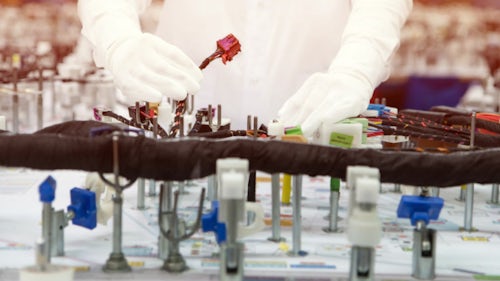Technology for increasing wire harness manufacturing efficiency
Tackle the challenges in wire harness manufacturing
In a high-volume industry like the automotive industry, rotary conveyor lines are often used, and wire harness designs are usually documented in a 2D non-scale product design drawing. Manufacturing engineers use this product design drawing to create a full-scale drawing enriched with manufacturing information, called a formboard drawing—these drawings provide visual aids for line operators. The goal of using these drawings is to enable a balanced production line design that allows the forecasted number of harnesses to be produced with the forecasted take-rates to reach the profitability zone as soon as possible. However, this takes time due to complexity, as operators invariably need to learn the tasks at hand to achieve their best possible performance.
Reduce time and errors in the current merged formboard process
Manufacturing engineers can design production lines to produce different but very similar harnesses on the same line by using merged formboards. Traditionally, such merged formboards are created manually using drawing tools that are not necessarily designed to reuse and share data. Because of this, the current merge process is a time-consuming and error-prone manual task that breaks data continuity and distracts manufacturing engineers from production line optimization tasks. Siemens offers alternatives to exclusive reliance on drawing tools that allow for the ability to reuse data, data continuity, integrated change management, and a wide range of automation capabilities.
Manage merged formboard creation and maintenance with contiguous data flows
Siemens Capital Formboard Manager enables the creation and maintenance of merged formboards in an environment based on contiguous data flows to help maximize the efficiency of production lines. Transitioning from a purely manual approach relying exclusively on drawing tools to one centered on linked data vastly reduces the effort required to merge and combine boards and production lines. Manufacturing engineers can then focus on what they do best and make better shop-floor decisions for harness manufacturers to reach the profitability zone faster while accommodating inevitable changes.
Download the white paper to learn more about the solution to increasing wire harness manufacturing efficiency.
